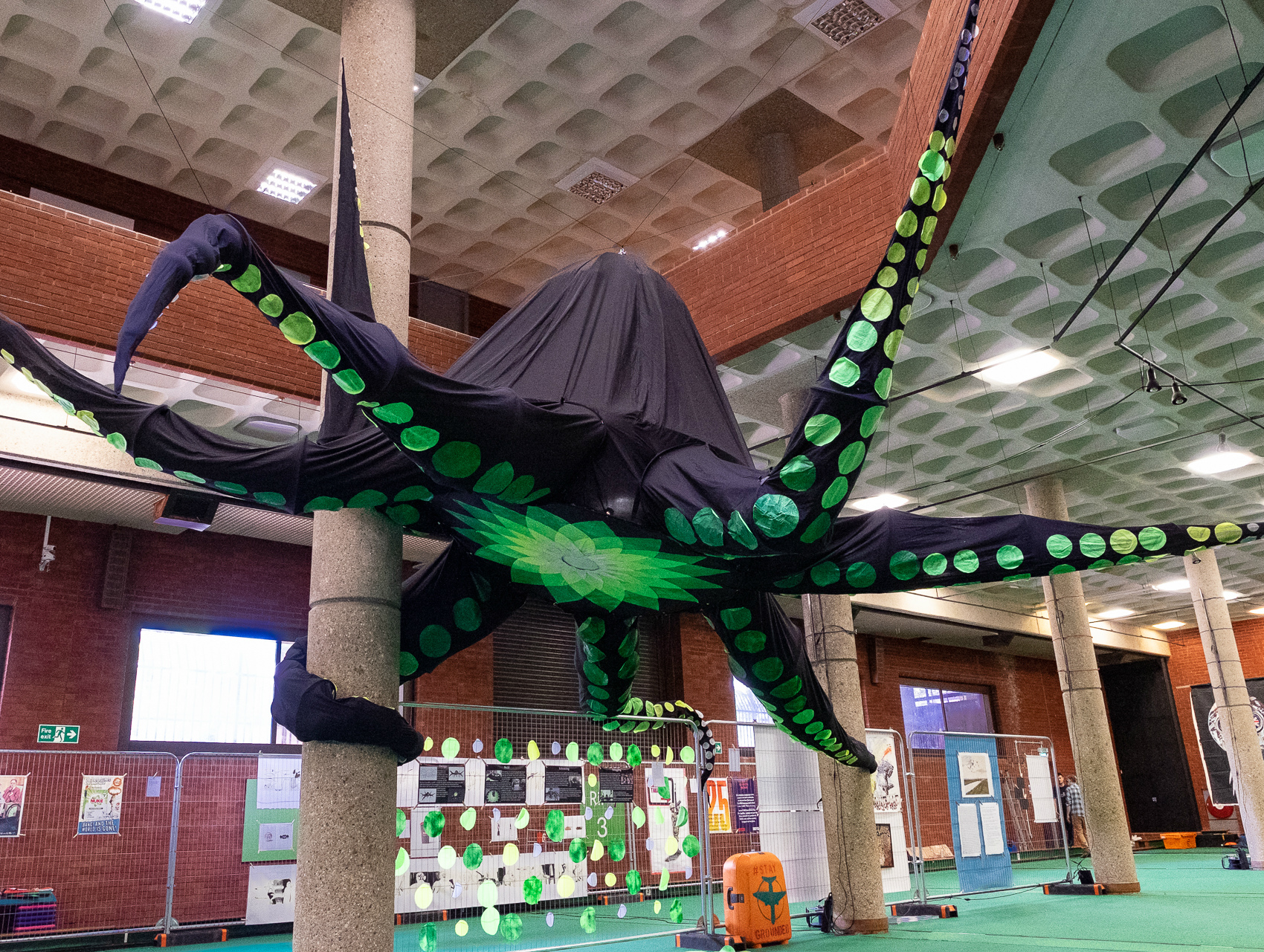
The artists who dramatically withdrew their work from a show at London’s Design Museum after it hosted an event for arms dealers are now having the last word. The group has teamed up to launch a bigger and scrappier version of the original show, titled “From Nope to Hope,” with the addition of work by high-profile names including the Guerrilla Girls and Tania Bruguera. The show’s organizers aim to ratchet up the pressure on museums and arts institutions that are facing growing criticism for taking money from defense industries and fossil-fuel companies.
The follow-up exhibition, which opened over the weekend in a sports center in South London, includes the withdrawn works plus new submissions by artists who have expressed solidarity with the protest, including Bruguera, Shepard Fairey, and Jeremy Deller. Amid recent news that Tate and the Van Gogh Museum would forego sponsorship from BP and Shell respectively, it is clear that cultural institutions have become a “battlefield,” Deller told artnet News. He says there is a “lack of transparency of businesses that puts huge pressure on open liberal institutions like museums.”
The show—put together on a shoestring budget and with un-museum-like speed—is a celebration of protest art of all kinds. It juxtaposes work criticizing the controversial sponsors of the Design Museum, the British Museum, and Tate with anti-Trump, anti-gentrification, and anti-Putin material.
The Design Museum’s directors, Deyan Sudjic and Alice Black, appeared surprised by the firestorm that formed in response to its decision to host an event for the Italian defense company Leonardo in July. Guests included representatives from the defense company Chemring, which “makes tear gas that was used on pro-democracy campaigners in Hong Kong,” says Gavin Grindon, who co-organized the protest show with Jess Worth.
Shepard Fairey’s Hope poster as a banner in “From Nope to Hope.” Photo by Luke Forsythe.
Grindon, who also co-organized a 2014 exhibition at the V&A dedicated to the design of protest movements, is disappointed that the museum declined to participate in a debate next Saturday about the ethics of museum fundraising. “We know the issue is nuanced,” Worth adds.
The Design Museum has pledged to review its fundraising policy in the wake of the controversy, but has not made any formal commitment to change its approach. A spokeswoman notes the “policies are in line with those of all other major cultural institutions around the world.”
The artist Peter Kennard, who withdrew his anti-war work Union Mask from the museum’s collection galleries in solidarity with the protesting artists, has lent a banner of the same work to the show. It hangs in the unlikely setting of an indoor bowling green in the Brixton Recreation Center alongside a banner-sized version of Shepard Fairey’s 2008 Hope poster. The American artist gave his blessing for the portrait of Barack Obama to be blown up and included in the show; in an accompanying caption, he expresses his disappointment at the Design Museum’s “poor judgement.”
Tania Bruguera’s protest art joins those withdrawn from the Design Museum in the unlikely setting of the Brixton Recreation Centre in South London. Photo by Ron Fassbender.
The Cuban activist-artist Tania Bruguera provided a new work that takes aim at Donald Trump and his opposition to gun control by showing the US President pointing a gun into his mouth alongside the slogan “Russian Roulette.”
Meanwhile, the Guerrilla Girls contributed a work about what it means to curate in the #MeToo era. Below the title, “How to write a museum wall text when the artist is a sexual predator,” the artists provide three versions of a wall text to a problematic artist’s portrait. One version is for museums “afraid of alienating billionaire collectors and trustees,” another for institutions conflicted about revealing an artist’s misbehavior, and the third is full-on Guerrila Girls-style confrontation.
But the star of the show comes courtesy the activist group BP or Not BP?. The group, known for its elaborate, theatrical protests of BP-sponsored cultural events, built a giant fabric octopus out of lightweight, collapsible fabric. Activists successfully snuck it past the British Museum security staff for a protest during “Sunken Cities,” a BP-sponsored show of underwater archaeology. And, apparently, they successfully smuggled it back out, too.
“From Nope to Hope: Arts Vs Arms, Oil and Injustice,” September 15 through September 23, Brixton Recreation Center, London.